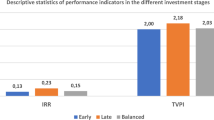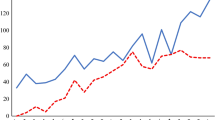Abstract
Richardson’s paper is a useful addition to the literature on the relationship between cash flow and investment. His approach to estimating this relationship is a new twist on earlier approaches. Like most of this literature, Richardson finds evidence that firms’ investment decisions are excessively sensitive to current cash flow, suggesting that violations of the Modigliani–Miller assumptions are empirically important. My view is that conceptual and implementation problems beset Richardson’s attempt to identify the specific violation of the Modigliani–Miller assumptions, and his evidence on this second point is not convincing.


Similar content being viewed by others
Notes
Hadlock (1998) makes a valiant effort to disentangle the impact of these imperfections using an empirical test based on managerial stock ownership.
References
Fama, E. F. (1980). Agency problems and the theory of the firm. Journal of Political Economy, 88, 288–307.
Hadlock, C. J. (1998). Ownership, liquidity, and investment. RAND Journal of Economics, 29, 487–508.
Hall, R. E., & Jorgenson, D. W. (1967). Tax policy and investment behavior. American Economic Review, 57, 391–414.
Hasset, K. A., & Hubbard, R. G. (2002). Tax policy and business investment. In A. J. Auerbach & M. S. Feldstein (Eds.), Handbook of public economics (Vol. 3). North-Holland, Amsterdam.
Hubbard, R. G. (1998). Capital-market imperfections and investment. Journal of Economic Literature, 36, 193–225.
Jensen, M. C. (1986). Agency costs of free cash flow, corporate finance, and takeovers. American Economic Review, 76, 323–329.
Lamont, O. (1997). Cash flow and investment: Evidence from internal capital markets. Journal of Finance, 52, 83–109.
Meyer, J. R., & Kuh, E. (1957). The investment decision. Cambridge, MA: Harvard University Press.
Modigliani, F., & Miller, M. (1958). The cost of capital, corporation finance, and the theory of investment. American Economic Review, 48, 261–297.
Rauh, J. D. (2006). Investment and financing constraints: Evidence from the funding of corporate pension plans. Journal of Finance, 61, 33–71
Stein, J. C. (2003). Agency, information, and corporate investment. In G. M. Constantinides, M. Harris, & R. M. Stulz (Eds.), Handbook of the economics of finance (Vol. 1A). North-Holland, Amsterdam.
Author information
Authors and Affiliations
Corresponding author
Rights and permissions
About this article
Cite this article
Bergstresser, D. Discussion of “Overinvestment of free cash flow”. Rev Acc Stud 11, 191–202 (2006). https://doi.org/10.1007/s11142-006-9002-3
Published:
Issue Date:
DOI: https://doi.org/10.1007/s11142-006-9002-3




